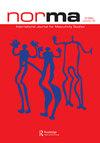Thinking about risk and vulnerability in CSMM
IF 1.5
Q2 SOCIOLOGY
引用次数: 1
Abstract
As the world nears a year and a half of a global pandemic, academic work has increasingly detailed the gendered effects of Covid-19. Whilst early on, data indicated that men were at a higher risk of dying from Covid-19 (Peckham et al., 2020), recent data has shown that women are in fact much more likely to suffer from Post Covid Syndrome (or ‘long Covid’) leading to long term potential health implications (Sudre et al., 2021). The explanations for this have been largely couched in terms of biology and the science of sex differences – predominantly around men’s weaker immune responses. Though, behavioural explanations arising from gendered socialisation and norms have also been offered for why men are more likely to catch, develop symptoms and die from Covid-19 (Ruxton & Burrell, 2020, p. 14). An article in The New York Times, for instance, argued in 2020 that adherence to ‘toxic masculinity’ is a predictor of whether or not men are likely to wear masks (Gupta, 2020), something which has empirical support (Mahalik, Bianca, & Harris, 2021), whilst others have shown that men are far less likely to comply with recommendations and more likely to under-rate the threat of Covid-19 than women (Galasso et al., 2020). Men also represent a lower percentage of those who are vaccinated with even one dose of a vaccine in many countries. Differences in vaccination rates are undoubtedly, in part, due to the fact that women are more likely to work as frontline workers in healthcare and elderly care but the differences also reflect gendered differences in approaches to health. The argument that gender affects men’s health is well-trodden territory: the question is why? Courtenay’s (2000) article on the necessity of including an analysis of masculinity in an analysis of wellbeing famously claimed that this could be explained through men’s attitude to risk through adherence to certain constructs of masculinity. As he notes: ‘men also construct masculinities by embracing risk. A man may define the degree of his masculinity, for example, by driving dangerously or performing risky sports – and displaying these behaviours like badges of honor’ (p. 1389). Lohan (2007, p. 498) similarly argues that men are, on average, both more likely to take health risks and far less likely to seek help for risks to their health than women. With regards to CSMM, how men regard their bodies has been important to conceptualising issues of risk. Connell’s analysis of the ‘body inescapable’ inMasculinities (Connell, 1995, pp. 52–56), as well as the experience of feelings and emotions in pro-feminist, men’s consciousness-raising groups (Seidler, 1991) have observed how the ‘disciplining’ of men’s bodies has been linked to embracing a Cartesian rationality of mind over matter (Lloyd, 1984; Seidler, 1994) where dominant forms of masculinity are expressed in the exercise of will. The ableism of such theories (Hearn, 2015), especially neglect the way in which ageing men, particularly, experience a sense of changing embodiment which might not be easily divided into discrete categories of positive or negative (Hearn & Sandberg, 2009; Thompson, 2018). This is where the interconnections between the twinned issues of risk and vulnerability come in. The issue of how risk relates to the Covid-19 pandemic has been highlighted in a previous NORMA editorial (Mellström, 2020) and how risk generally relates to masculinity has been关于CSMM中风险和脆弱性的思考
随着全球疫情接近一年半,学术工作越来越详细地阐述了新冠肺炎的性别影响。虽然早期的数据表明,男性死于新冠肺炎的风险更高(Peckham et al.,2020),但最近的数据显示,女性实际上更容易患上新冠肺炎后综合征(或“长期新冠肺炎”),从而导致长期潜在的健康影响(Sudre et al.,2021)。对此的解释主要体现在生物学和性别差异科学方面,主要围绕男性较弱的免疫反应。尽管如此,对于为什么男性更容易感染新冠肺炎、出现症状和死亡,性别化社交和规范产生的行为解释也被提供(Ruxton&Burrell,2020,第14页)。例如,《纽约时报》2020年的一篇文章认为,坚持“有毒的男性气质”是男性是否可能戴口罩的预测因素(Gupta,2020),这一点得到了实证支持(Mahalik,Bianca,&Harris,2021),而其他研究表明,与女性相比,男性遵守建议的可能性要小得多,更可能低估新冠肺炎的威胁(Galasso et al.,2020)。在许多国家,即使接种了一剂疫苗,男性在接种者中所占比例也较低。疫苗接种率的差异无疑在一定程度上是由于女性更有可能在医疗保健和老年护理领域担任一线工作者,但这种差异也反映了健康方法的性别差异。性别影响男性健康的论点是老生常谈:问题是为什么?Courtenay(2000)关于在幸福感分析中纳入男性气质分析的必要性的文章著名地声称,这可以通过男性对风险的态度来解释,因为他们坚持某些男性气质的结构。正如他所指出的:“男性也通过接受风险来塑造男性气质。一个男人可以定义他的男子气概的程度,例如,通过危险驾驶或进行危险的运动——并将这些行为表现为荣誉徽章”(第1389页)。Lohan(2007,第498页)同样认为,平均而言,男性比女性更有可能承担健康风险,也不太可能为健康风险寻求帮助。关于CSMM,男性如何看待自己的身体对风险问题的概念化很重要。Connell对男性气质中“身体不可避免”的分析(Connell,1995,第52-56页),以及支持女权主义的情感体验,男性意识提升团体(Seidler,1991)观察到,男性身体的“自律”如何与接受笛卡尔思维对物质的理性联系在一起(Lloyd,1984;塞德勒,1994),在这种理性中,男性气质的主导形式通过意志的行使来表达。这些理论的能力论(Hearn,2015)尤其忽视了老年男性体验变化化身的方式,这种方式可能不容易被划分为积极或消极的离散类别(Hearn&Sandberg,2009;汤普森,2018)。这就是风险和脆弱性这两个双重问题之间的相互联系。风险如何与新冠肺炎大流行相关的问题在之前的NORMA社论中得到了强调(Mellström,2020),风险通常如何与男性气概相关
本文章由计算机程序翻译,如有差异,请以英文原文为准。
求助全文
约1分钟内获得全文
求助全文
来源期刊

NORMA
Social Sciences-Gender Studies
CiteScore
3.00
自引率
14.30%
发文量
23
期刊介绍:
NORMA is an international journal for high quality research concerning masculinity in its many forms. This is an interdisciplinary journal concerning questions about the body, about social and textual practices, and about men and masculinities in social structures. We aim to advance theory and methods in this field. We hope to present new themes for critical studies of men and masculinities, and develop new approaches to ''intersections'' with race, sexuality, class and coloniality. We are eager to have conversations about the role of men and boys, and the place of masculinities, in achieving gender equality and social equality. The journal was begun in the Nordic region; we now strongly invite scholarly work from all parts of the world, as well as research about transnational relations and spaces. All submitted manuscripts are subject to initial appraisal by the Editors, and, if found suitable for further consideration, to peer review by independent, anonymous expert referees. All peer review is double blind and submission is online via Editorial Manager.
 求助内容:
求助内容: 应助结果提醒方式:
应助结果提醒方式:


